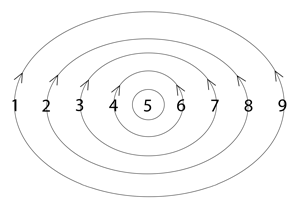institutionalized education
3-1-4
Conventional Understanding
We typically think of institutionalized education as a system where authorities transfer knowledge to students through standardized methods. We view creation as making something new through talent or effort. Both concepts suggest that something is produced that didn’t exist before – either knowledge in a student’s mind or a novel creation in the world. We rarely question whether education might be about recognizing patterns rather than acquiring information, or whether creation might involve perceiving what’s already present rather than manufacturing something new.
Resonant Understanding
Word Cosmology reveals both “institutionalized education” and “creation” carrying a 3-1-4 resonance pattern, showing they express the same fundamental frequency. Like morning dew that doesn’t create the spider’s web but simply makes it visible, both correspond with the moment when awareness recognizes patterns emerging within it. This challenges our view by suggesting that both education and creation naturally function as consciousness recognizing itself through patterns that were already present but not yet visible. This explains why both learning and creative insights often arrive through moments of clarity rather than forced effort.
Expressions Spectrum Analysis
In balanced expression, this resonance pattern appears as “conscious knowing,” “flow state,” and “self-organizing of attention,” revealing how both education and creation naturally involve awareness recognizing emerging patterns. “Being present with space” shows how both naturally involve receptive presence rather than force.
When over-modulated, expressions include “institutionalized education” itself, “systems of control,” and “focused on a thought,” revealing how this pattern becomes distorted through predetermined outcomes. “Storage” and “accumulated energy” show how over-modulation attempts to contain what naturally flows. This explains why institutionalized education often feels controlling rather than liberating.
Under-modulated expressions such as “disconnected self,” “dead space,” and “contracted” demonstrate what happens when this pattern lacks coherence to recognize patterns clearly. This explains the confusion and resistance many experience in educational settings where genuine pattern recognition is absent.
Beyond these, uncategorized terms like “creation,” “octaves,” and “movement of energy” also share this resonance, suggesting fundamental principles rather than human experiences. Notably, “creation” appears in the uncategorized column of the institutionalized education table, indicating its function as a universal principle.
Russell’s Cosmogony Connection
Walter Russell describes how consciousness recognizes patterns: “Mind thinking sets divided idea into two-way opposed motion to produce the effect of simulating idea by giving form to it. Formed bodies are but pressure-conditioned motion, however. They are not the IDEA which they simulate.”
This connects with both education and creation functioning as recognition rather than manufacturing. Like lighting a room doesn’t create the furniture but reveals what was already there, neither education nor creation manufactures reality but makes patterns perceptible through conscious recognition.
Russell further explains: “This eternally-creating universe, which is God’s eternally-renewing body, is the product of Mind-knowing expressed through Mind-thinking.” This aligns with both education and creation functioning at position 4 in the creative sequence—where consciousness emerges to recognize what’s already present in potential.
Practical Implications
Understanding institutionalized education and creation as sharing the same resonance pattern transforms how we approach learning. Instead of viewing education as imposing knowledge, we might recognize it as cultivating conditions where awareness naturally recognizes patterns. This explains why effective learning environments aren’t those with rigid structures but those that foster “conscious knowing” and “flow state.”
This challenges educational narratives that position learning as accumulation rather than recognition. When we see that institutionalized education represents an over-modulation of the same pattern that manifests as creation, we understand why creative thinking often feels at odds with institutional structures.
By aligning with balanced expressions of this pattern, we might transform educational practices from transferring information to cultivating pattern recognition. This could manifest as environments where learners organize around authentic interests and where the natural relationship between consciousness and emerging patterns is honored rather than managed.
Walter Russell’s quotes are from his book, “A New Concept of the Universe”.


